|
Recent Opera Round-up

with RODERIC DUNNETT
2. Peter Grimes - Hungarian State Opera, Budapest.

The Hungarian State Opera, on Budapest's Andrassy Street, home to the
first underground Metro system in continental Europe (predating even Paris),
was quick off the mark to stage Britten's Peter Grimes after its
première at London's Sadler's Wells. The Budapest production, mounted
just after the war in a capital reeling from the Horthy dictatorship and
only recently ravaged by the SS and Hungarian Arrow Cross fascist militia,
was timely. Few settings could have been more apt for a tale of the outsider
hounded to oblivion by collective urban terrorism and the suspicious mass
mentality.
That new production had a considerable number of revivals, and continued
in the repertoire till the early l960s - an impressive feat in itself. The
30-year old rising Budapest director Balazs Kovalik's new production, staged
in Hungarian and the first fresh staging since that original première,
moves onto new ground and proves a far cry from the statuesque opera productions
that are still a feature of some East European opera houses.
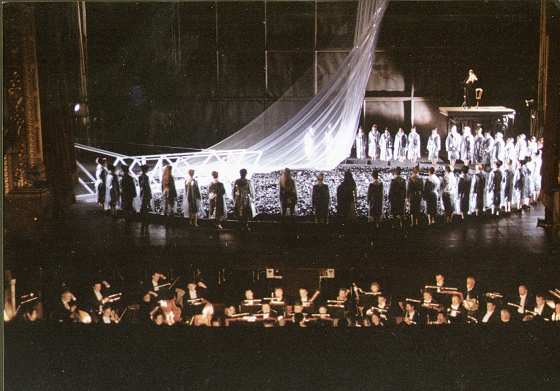
Chorus and Orchestra of the Hungarian State Opera, Budapest
in Balazs Kovalik's new production of PETER GRIMES
Photo copyright: Béla Mezey
Kovalik trained in Munich, where he made his mark in contemporary repertoire,
including Ligeti's Le Grand Macabre and Sandor Szokolay's particularly
terse, powerful opera based on Federico Garcia Lorca's play Blood Wedding.
What's more, he seems to know his Britten inside out (he visited Aldeburgh
privately to work out for himself the ambience of East coast England). The
resultant production focuses on the essentials and captures the very essence
of Peter Grimes, just as conductor Janos Kovacs' beautifully-paced reading
conjured not just the power but the full irony of Britten's seminal score.
The State Opera House orchestra's string playing, not just for the half-dozen
sea interludes, but throughout, was out of this world.
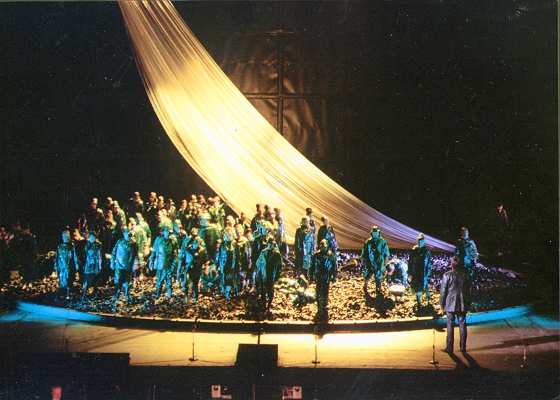
The ominous chorus. Photo copyright: Béla Mezey
Kovalik has, controversially, gone for a new look. He daringly and imaginatively
sweeps aside the huddles of toytown houses and ramshackle cardboard-cutout
inns familiar from early Peter Grimes productions, shifting Grimes's
Borough instead into the stark visual directness - coupled with dazzling
colour delineation - of a late l950s Bayreuth staging by Wieland Wagner.
Csaba Antal's set, with a vast, Parsifal-like overhanging chandelier
which later descends to enmesh (literally) the constantly threatening, black-booted
and yellow sou-wester'd chorus (vocally superb forces, meticulously prepared
by the State Opera House's chorus master, Aniko Katona, whose massed singing
rivals even the legendary Welsh National Opera Chorus) has the feeling of
a vast, impoverished, derelict beach, an apt trysting place for the sundry
emotional derelicts of Peter Grimes.
Hoisted front of proscenium on raised platforms, Swallow (Peter Fried)
and Ellen (Katalin Pitti), are established strongly from the start : both
are mature performers, with a marked strength of delivery. Tamas Busa is
a convincingly sympathetic Balstrode (paired with Andras Kaldi Kiss : the
whole opera is double-cast). Auntie (the strong Annamaria Kovacs), Ned Keene
(Gabor Garday), Bob Boles (Ferenc Gerdesits), the nieces - all the side
characters, in fact, are played not so much as individuals as Expressionistic
offshoots necessary to the main action, individual incarnations of the lethal
and emotionally crushing chorus.
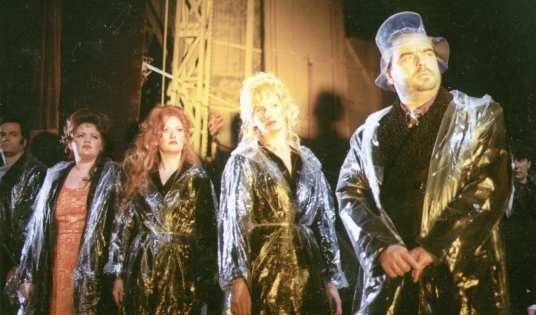
From left to right: Balstrode (Andra's Ka'ldi Kiss),
Auntie (Bernadett Wiedemann), Auntie (Edit Hruby),
Auntie (E'va Va'r Helyi), Swallow (Sa'ndor Egri)
from cast 2 of Peter Grimes
Photo copyright: Béla Mezey
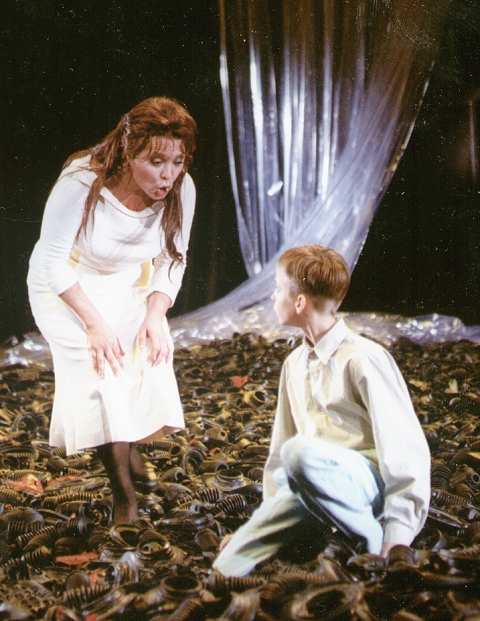
Julia Kukely (Ellen Orford) and Tamás Varga (John).
Photo copyright: Béla Mezey
The self-conscious stylising works well much, if not all, of the time.
Kovalik's staging makes its real impact through his three main leads.
His unusually sensitive handling of Grimes himself, Ellen and the doomed
apprentice boy, John (played with breathtaking naturalness and unconscious
insight by young Marton Szabo, alternating with Tamas Varga) produces a
quite extraordinary measure of poignancy. Visually, he contrives of them
together a kind of blue-period Picasso family unit. By a simple rearstage
trick of transparent curtaining (one that, unlike some others, undoubtably
works), he has the boy perish on stage : Grimes's return bearing the corpse,
to which he clings like some kind of talisman - he looks like Lear bearing
Cordelia or Macduff his butchered children - is a piece of absolutely stunning
staging. Andras Molnar, doubling with Denes Gulyas, brings to Grimes himself
uncomplicated acting, a glorious voice and - albeit a little passively -
precisely the kind of pathos Peter Grimes requires.
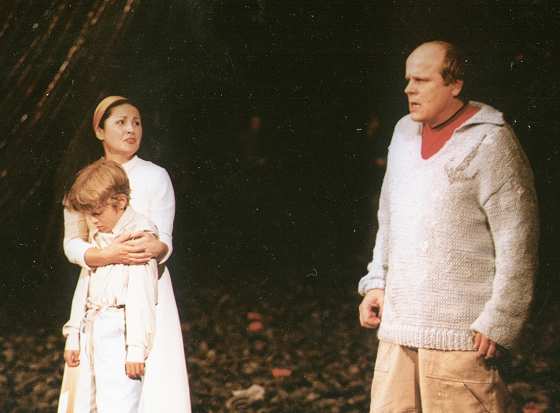
Katalin Pitti (Ellen), Andras Molnar (Peter Grimes)
and Marton Szabo (John).
Photo copyright: Béla Mezey
Copyright © 3 April 2000 Roderic Dunnett,
Coventry, UK
 << Music &
Vision homepage
More recent operas >>
<< Music &
Vision homepage
More recent operas >>
|